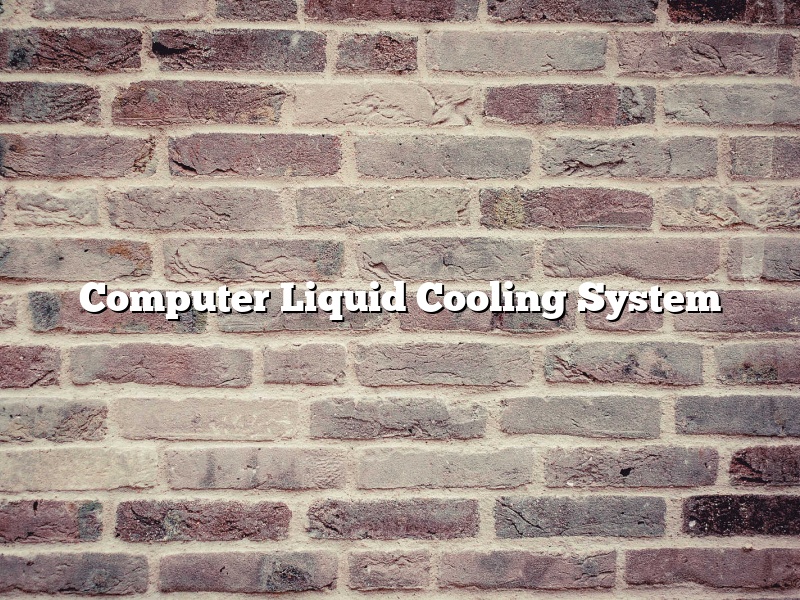Computer liquid cooling systems (CLCS) are special cooling systems designed to cool computer processors and graphics cards. While there are a variety of different types of CLCS on the market, all work by circulating a liquid coolant through a series of pipes that run from the processor or graphics card to a radiator. The radiator is then cooled by air flowing through it, which in turn cools the liquid coolant. This cooled liquid is then circulated back to the processor or graphics card, where it absorbs the heat and dissipates it into the surrounding air.
One of the benefits of using a CLCS is that it can often run cooler than traditional air-cooled systems. This is because computers generate a lot of heat, and air-cooling systems can only dissipate so much of it. By contrast, liquid coolants can absorb and dissipate a lot more heat, making them ideal for high-performance processors and graphics cards.
Another benefit of CLCS is that they are often more efficient than air-cooled systems. This is because liquid coolants can flow through pipes more easily than air, meaning they can more effectively cool the processor or graphics card.
There are a number of different types of CLCS on the market, but the most common are closed-loop systems. These systems typically consist of a waterblock (which attaches to the processor or graphics card), a pump, a radiator, and a reservoir. The waterblock is filled with coolant, which is then pumped through the radiator and back to the waterblock. This system is sealed, meaning that the coolant cannot escape or mix with the surrounding air.
Other types of CLCS include open-loop systems and all-in-one systems. Open-loop systems are similar to closed-loop systems, but the reservoir is open to the atmosphere. This means that the coolant can evaporate, which can lead to instability and performance issues. All-in-one systems are similar to closed-loop systems, but the waterblock, pump, and radiator are all integrated into a single unit.
CLCS are not without their drawbacks, however. One of the main drawbacks is that they can be expensive. This is because they require a number of specialized components, such as a waterblock, pump, and radiator.
Another drawback of CLCS is that they can be difficult to install. This is because they require a fair amount of plumbing, and the installation process can be complicated.
Despite these drawbacks, CLCS are becoming increasingly popular, as they offer a number of benefits over traditional air-cooled systems. If you are looking for a cooler, more efficient way to cool your computer, a CLCS may be the right choice for you.
Contents [hide]
Is liquid cooling good for PC?
Is liquid cooling good for PC?
It depends. Liquid cooling can be a great way to cool your PC, but it’s not always necessary or the best option.
There are a few things to consider when deciding if liquid cooling is right for you. First, you need to make sure your case can accommodate a liquid cooling system. Some cases have special brackets or mounts for liquid cooling, while others do not.
Second, you need to make sure your motherboard supports liquid cooling. Not all motherboards do, so you’ll need to check before you buy.
Third, you need to make sure you have enough room to install a radiator. A radiator is what transfers heat from the CPU to the liquid cooling system. If your case doesn’t have enough room, you may need to get a new one.
Finally, you need to make sure you’re comfortable installing and maintaining a liquid cooling system. If you’re not comfortable working with small parts and tight spaces, you may want to have a professional install your liquid cooling system for you.
If you can answer “yes” to all of these questions, then liquid cooling may be a good option for you. Liquid cooling can provide better cooling performance than air cooling, and it can be less noisy. It’s also a great way to keep your PC running cool and quiet during extended gaming sessions or video editing marathons.
Liquid cooling isn’t for everyone, but it’s a great option for those who are comfortable with it. If you’re looking for a cooler, quieter PC, liquid cooling may be the right choice for you.
What is a liquid cooling system for PC?
A liquid cooling system for a PC, also known as a water cooling system, is a type of cooling system that uses water to cool the PC’s internal components.
A PC’s internal components, such as the CPU, graphics card, and hard drive, generate a lot of heat when they are being used. A liquid cooling system helps to keep these components cool by transferring the heat they generate to water, which is then cooled by a fan.
A liquid cooling system is a great option for people who want to overclock their PC, as it can help to keep the internal components cool and stable. It is also a good option for people who want to reduce the noise their PC makes, as a liquid cooling system can be quieter than a traditional air cooling system.
There are a few different types of liquid cooling systems that you can choose from. The most common type is a closed-loop system, which is a system that comes with a pre-filled water cooler that you install in your PC. There are also open-loop systems, which are systems that allow you to add your own water cooler to your PC.
If you are interested in installing a liquid cooling system in your PC, be sure to research the different types of systems available and choose the one that is best for you.
How often should you change the liquid in a liquid cooled PC?
Like most things in life, how often you should change the liquid in your liquid cooled PC depends on how you use it. If you’re a heavy gamer or overclocker, you’ll need to change it more often than someone who just uses their computer for browsing the internet and checking email.
The general consensus is that you should change the liquid in your liquid cooled PC every 6-12 months, but this can vary depending on the type of liquid you’re using, the quality of the cooling system, and how often the PC is used.
If you’re using a high-quality liquid like distilled water or propylene glycol, you can probably go 6-12 months without any problems. However, if you’re using a lower-quality liquid like ethylene glycol, you’ll need to change it more often – possibly every 3-6 months.
If you’re overclocking or gaming heavily, you’ll also want to make sure you monitor the liquid’s pH level and make sure it’s in the correct range. If it falls out of range, you’ll need to change the liquid immediately.
In general, if you’re using a good quality liquid and keeping an eye on the pH level, you should be able to go 6-12 months without any problems. Just be sure to change it if the pH level falls out of range.
How much does it cost to fully liquid cool a PC?
Liquid cooling has been around for years, but in recent times it has become more popular as PC builders have looked for ways to keep their systems cool. There are many different types of liquid cooling, but the most common is to use a waterblock to cool the CPU and a radiator to cool the water.
A full liquid cooling system can be expensive, but there are many different options to choose from. A basic system could cost around $100, while a more advanced system could cost $500 or more. The most important factor in determining the cost of a liquid cooling system is the size of the radiator. The bigger the radiator, the more water can be cooled, and the more expensive the system will be.
There are several other factors that can affect the cost of a liquid cooling system, including the type of waterblock, the type of tubing, and the type of fan. Some waterblocks are more expensive than others, and some types of tubing and fans are more expensive than others.
Ultimately, the cost of a liquid cooling system will depend on the size of the radiator, the type of waterblock, the type of tubing, and the type of fan. The most important factor is the size of the radiator, which can vary from $50 to $200 or more.
Will liquid cooling leak?
Liquid cooling is a process of transferring heat away from a component or system using a liquid coolant. Because liquids have a much higher heat capacity than air, they are able to remove heat more effectively.
One of the benefits of liquid cooling is that it is much less likely to leak than traditional air cooling. This is because liquid is contained within a closed system, whereas air can escape through any cracks or openings.
However, liquid cooling can still leak if the system is not properly sealed. If the coolant leaks out, it can cause serious damage to the components and system.
So, will liquid cooling leak? It depends on the system and how well it is sealed. If the system is properly sealed, then it is unlikely to leak. However, if the system is not sealed properly, then it could leak and cause damage.
How long do liquid coolers last?
How long do liquid coolers last?
This is a question that a lot of people have, and it is a valid question. After all, why would you buy a liquid cooler if it is only going to last for a year or two?
The truth is that liquid coolers can last for a long time. In fact, many people find that they can use the same liquid cooler for years without any problems.
There are a few things that you can do to make sure that your liquid cooler lasts as long as possible. First, you should make sure that you keep the liquid cooler clean. If you allow dirt and dust to build up, it can damage the cooler.
You should also make sure that you keep the liquid coolant in the cooler. If the liquid coolant level gets too low, it can cause the cooler to stop working.
Finally, you should make sure that you don’t overclock your computer. overclocking can cause the liquid cooler to break down prematurely.
Overall, if you take care of your liquid cooler, it can last for a long time.
Is liquid cooling hard to maintain?
Liquid cooling is a process of transferring heat away from a computer’s central processing unit (CPU) and graphics processing unit (GPU) to a radiator. The radiator is then cooled by a liquid, typically water.
Liquid cooling is often considered more difficult to maintain than traditional air cooling. However, with a little care and maintenance, liquid cooling can be a very effective way to keep your computer running cool.
The most important thing to remember when caring for a liquid-cooled computer is to keep the radiator clean. The radiator must be free of dust and other debris in order to effectively cool the computer’s components.
The best way to clean the radiator is to remove it from the computer and use a soft brush to dislodge any dust or debris. You can also use a garden hose to spray water on the radiator to clean it off.
Once the radiator is clean, be sure to reinstall it properly. Make sure all of the screws are tight and that the radiator is properly seated in the computer.
If you are using a liquid cooling system that requires coolant, be sure to check the level of the coolant on a regular basis. The coolant should be checked every time you change the computer’s filter.
If the level of the coolant is low, add more coolant to the system. Be sure to use the correct type of coolant and to follow the manufacturer’s instructions when adding coolant to the system.
In general, liquid cooling is a bit more difficult to maintain than traditional air cooling. However, with a little care and maintenance, liquid cooling can be an effective way to keep your computer running cool.




